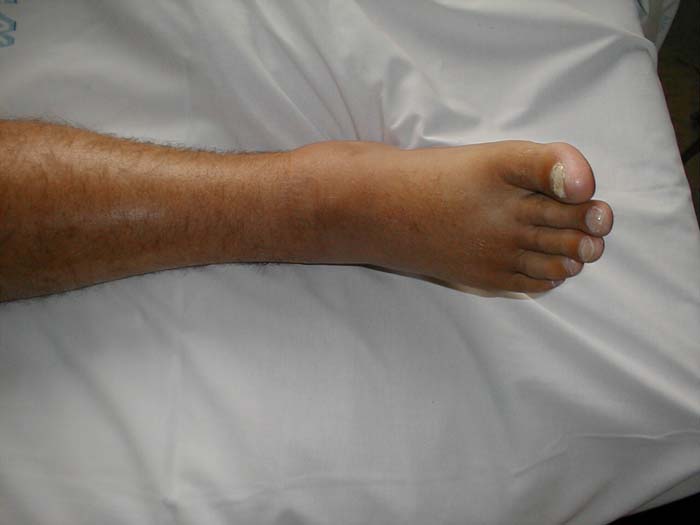Peripheral edema
| Peripheral edema | |
 | |
|---|---|
| Massive peripheral edema (Image courtesy of Charlie Goldberg, M.D., UCSD School of Medicine and VA Medical Center, San Diego, CA) | |
| ICD-10 | R60.0 |
| ICD-9 | 782.3 |
Template:Search infobox Editor-In-Chief: C. Michael Gibson, M.S., M.D. [1]
Please Take Over This Page and Apply to be Editor-In-Chief for this topic: There can be one or more than one Editor-In-Chief. You may also apply to be an Associate Editor-In-Chief of one of the subtopics below. Please mail us [2] to indicate your interest in serving either as an Editor-In-Chief of the entire topic or as an Associate Editor-In-Chief for a subtopic. Please be sure to attach your CV and or biographical sketch.
Overview
Competent venous valves, intermittent leg muscle contraction and respiration is required to support normal venous blood return. When these fail, venous insufficiency and edema occur. Edema can occur in 2 forms: pitting and non-pitting. Pitting occurs when there is fluid movement when pressure is applied. Non-pitting is swelling of the tissue itself, not an excess of fluid surrounding the tissue.
Epidemiology and Demographics
25% of the general population suffers from chronic venous insufficiency.
Differential diagnosis of causes of peripheral edema
In alphabetical order: [1] [2]
Diagnosis
History and Symptoms
- History should include:
- DVT risk factors
- time lapse
- other associated symptoms
- unilateral vs. bilateral
- pitting and/or non-pitting
(Images courtesy of Charlie Goldberg, M.D., UCSD School of Medicine and VA Medical Center, San Diego, CA)
Laboratory Findings
- Labs include:
Chest X Ray
- Chest X-Ray may indicate pulmonary edema and/or cardiomegaly
Echocardiography or Ultrasound
- Duplex ultrasound for DVT
- Echocardiography for EF in patients with CHF
Other Diagnostic Studies
Treatment
Acute Pharmacotherapies
Chronic Pharmacotherapies
- DVT: Anticoagulation with unfractionated heparin, low molecular weight heparin / warfarin for 3-6 months
Indications for Surgery
- Nephrotic syndrome: transplant in adult patients may be necessary
- Cirrhosis: liver transplant may be necessary
Additional therapies
- Venous insufficiency: Leg elevation, compression stockings, minimize time standing
- Cellulitis: extremity elevation
- CHF: Salt restrictions
- Cirrhosis: Diuretics & low salt diet
Prognosis
Successful treatment depends on control of the underlying cause. Severe swelling can cause permanent damage to nerves, resulting in peripheral neuropathy. Many cases from temporary or minor causes resolve on their own, with no lasting damage.
References
Additional Resources
- Cho S, Atwood J (2002). "Peripheral edema". Am J Med. 113 (7): 580–6. doi:10.1016/S0002-9343(02)01322-0. PMID 12459405.
